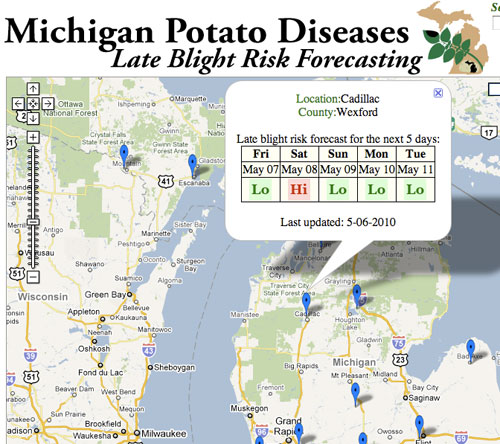Five-day potato late blight forecast now available for Michigan
Editor’s note: This article is from the archives of the MSU Crop Advisory Team Alerts. Check the label of any pesticide referenced to ensure your use is included.
With funding from Project GREEEN and the North Central IPM Center the potato pathology program at MSU and Dr. Kathleen Baker at WMU have been developing a disease-forecasting model that generates accurate predictions of late blight risk up to five days in the future. A potato late blight prediction model has been available to growers through the Late Blight Risk Management website (www.lateblight.org) run by MSU since 2000. This model is used to estimate environmental conditions that are favorable for epidemic risk, and then provides fungicide recommendations appropriate to that risk. The new model derives hourly microclimate variables associated with potato late blight risk from the National Weather Service forecast data. This data is then fed into a neural network computer program, which generates high or low risk estimation. Although this new model is not a replacement for the old model, it increases the amount of information available to growers, enabling them to take the necessary preventative actions to manage late blight risk, such as the timely application of an effective fungicide. The new model is now available on the late blight website by clicking on the “5-Day Forecast” link in the left hand menu on the home page or visiting the webpage http://www.lateblight.org/neuroweather.php (Figure 1).
Figure 1. Clipped image of five-day late blight risk forecast for Cadillac, Michigan.

Another new addition to the late blight disease-forecasting site is the ability to keep track of important news on late blight in Michigan using Twitter. To follow the late blight site on Twitter, click on the “Follow us on Twitter” button on the home page or go to http://twitter.com/late_blight.
Variables to generate the risk status include, the day of the year; latitude and longitude of the weather stations; maximum and minimum temperatures; 12-hour Probability of Precipitation forecast (PoP), Quantitative Precipitation Forecast (QPF), and cloud cover values extracted directly through the National Weather Service. Additional variables derived from these extracted values were daily temperature range, sum of 12-hour PoP values, clear days (both 12-hour cloud cover values indicated clear) and cloudy days (both 12-hour cloud cover values indicated cloudy). Potato late blight day typing values from the Michigan State University modified-Wallin method included a dry day DSV (assuming no precipitation), a wet day DSV (assuming enough precipitation throughout the day to keep the relative humidity above 80 percent), and the range of DSV values between the wet and dry day calculations.
Dr. Kirk's work is funded in part by MSU's AgBioResearch.



 Print
Print Email
Email



